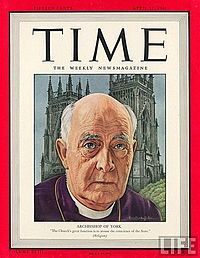- Cyril Garbett
-
Cyril Garbett Archbishop of York 
Garbett on the cover of TIME in 1944Enthroned 1942 Reign ended 1955 Predecessor William Temple Successor Michael Ramsey Personal details Born 6 February 1875
Tongham, SurreyDied 31 December 1955
West Riding of YorkshireCyril Forster Garbett GCVO PC (6 February 1875 – 31 December 1955) was an Anglican clergyman, and Archbishop of York from 1942 until 1955.
Contents
Early life
Garbett was born in the village of Tongham in Surrey, next to Aldershot in Hampshire, the son of the vicar of Tongham. At the age of 11 he was sent up to Portsmouth Grammar School and thence to Keble College, Oxford in 1894. At Oxford, he received a call to the ministry and moved to Cuddesdon Theological College to study theology and prepare for ordination.
Garbett was ordained in 1899 as a deacon and was sent to be a curate of St Mary's Portsea, at which church he was ordained to the priesthood in 1901 and where he remained until 1919, after 1909 as its vicar. In 1911 he was joined at Portsea by the newly ordained George Armitage Chase, who would later serve Garbett, on elevation to the episcopate, as examining chaplain.[1]
From there he was consecrated as Bishop of Southwark, where he remained until his translation as Bishop of Winchester in 1932, before finally in 1942 he became Archbishop of York.
Archbishop of York
Garbett was popular public figure, especially as a pastoral Bishop, famous for trudging the length of his dioceses and Archdiocese with his walking stick, visiting both clergy and lay people in the towns he passed through. Although personally warm, he had a reputation as a firm disciplinarian with clergy in his dioceses.
Politically and theologically, he is best seen as a transitional figure between the Edwardian and modern periods of the Church of England. A staunch nationalist and royalist, he held an erastian view of the Church of England clearly as a national church, and he held strongly traditional views of issues such as family relationships, sexual morality and corporal punishment.
On the other hand, Garbett belonged to the generation which was comfortable with the idea of diversity in the Church of England, and had little patience for High Church versus Low Church struggles. He was a pioneer of the Ecumenical Movement, and during and after the Second World War travelled extensively, including to Communist Bloc countries. Although generally perceived as leaning rightwards politically, he was comfortable with the welfare state which emerged during his Archiepiscopate.
His trip 19 – 28 September 1943, at the invitation of the Moscow Patriarchate, to Moscow where he was greeted by the newly installed Moscow Patriarch Sergiy (Stragorodskiy),[2][3] was used by Stalin's propaganda machine to spread falsehoods about religious freedom in the USSR[4]: on the 24th, the New York Times quoted Archbishop Garbett as stating that "he was convinced that there was the fullest freedom of worship in the Soviet Union". However, during the Cold War, Garbett denounced Communism as un-Christian and actively supported the British government line.
On 17 April 1944 Garbett featured on the cover of TIME magazine after he had been persuaded by the British Ministry of Information to go to the United States to discuss religious freedom in Russia. During this visit he stated "Marshall Stalin, being a great statesman, has recognised the power of religion."[5]
Garbett's visit to Dublin where he met President De Valera was considered significant.
Garbett sat in the House of Lords for many years as a Lord Spiritual, and he took these duties as an erastian very seriously. On his retirement he was offered and accepted a hereditary barony, but he died before this could be legally created. It is thought he was to take the title Baron Garbett of Tongham.
Final years
Garbett continued to work ferociously into his late seventies, which eventually took its toll. On his eightieth birthday, 6 February 1955, he retired from active ministry and was created a Knight Grand Cross of the Royal Victorian Order. Later that year, he underwent surgery, and spent the last months of his life in a convalescent home where he continued to write and correspond until his death, on New Year's Eve 1955.
References
- ^ Obituary of George Armitage Chase, The Times, 1 December 1971
- ^ Журнал Московской Патриархии. 1943, # 2, pp 18 – 23
- ^ I.F.ColquhounRussia. Manipulates the Church. Then ... and NOW!
- ^ Dianne Kirby. The Church of England and 'Religions Division' during the Second World War: Church-State Relations and the Anglo-Soviet Alliance
- ^ [1] Kent, Bruce Review of Church, State and Propaganda: The Archbishop of York and International Relations – a policy study of Cyril Forster Garbett, 1942–1955 University of Hull Press (1999)
Church of England titles Preceded by
Hubert BurgeBishop of Southwark
1919–1932Succeeded by
Richard ParsonsPreceded by
Frank WoodsBishop of Winchester
1932–1942Succeeded by
Mervyn HaighPreceded by
William TempleArchbishop of York
1942–1955Succeeded by
Michael RamseyClerks of the Closet since 1908 William Boyd-Carpenter • Hubert Murray Burge • Thomas Banks Strong • Cyril Garbett • Percy Herbert • Roger Wilson • Gordon Fallows • John Bickersteth • John Waine • Jonathan Bailey • Christopher Hill •
Bishops of Winchester since 1908 Herbert Ryle • Edward Talbot • Frank Woods • Cyril Garbett • Mervyn Haigh • Alwyn Williams • Falkner Allison • John Taylor • Colin James • Michael Scott-Joynt • Tim Dakin
Categories:- 1875 births
- 1955 deaths
- Alumni of Ripon College Cuddesdon
- People from Tongham
- Members of the Privy Council of the United Kingdom
- Old Portmuthians
- Bishops of Southwark
- Bishops of Winchester
- Archbishops of York
- 20th-century Anglican archbishops
- Knights Grand Cross of the Royal Victorian Order
- Alumni of Keble College, Oxford
- Clerks of the Closet
Wikimedia Foundation. 2010.
